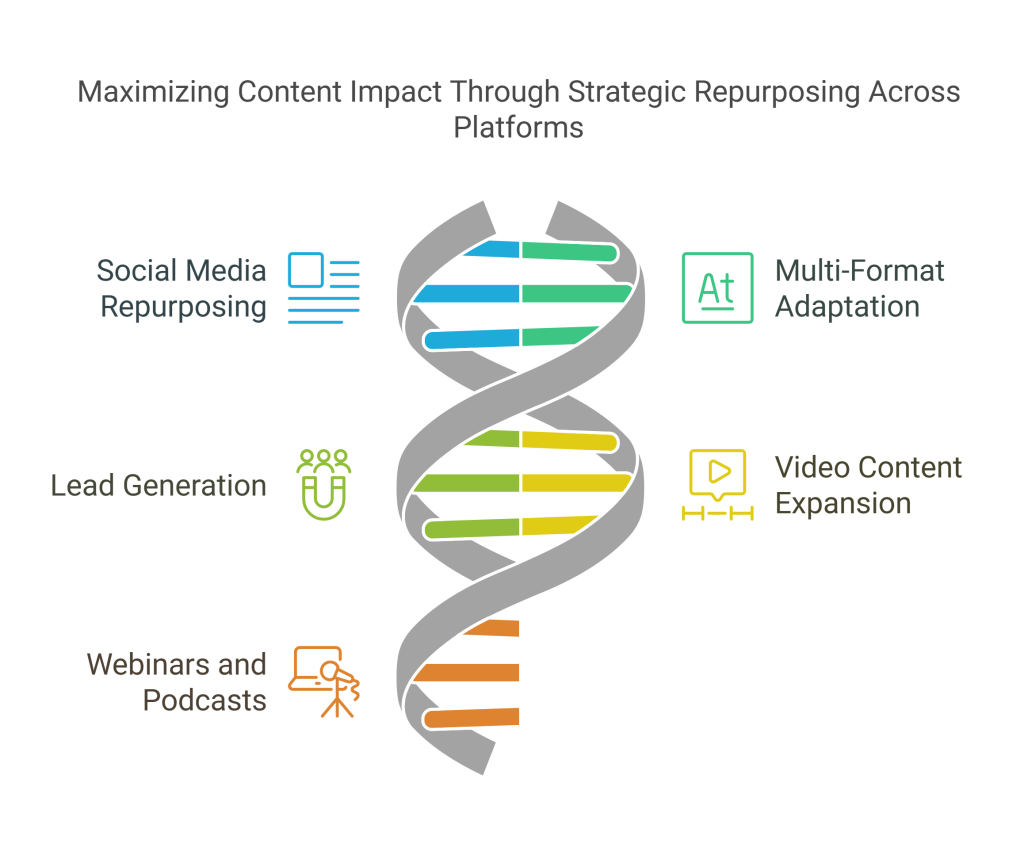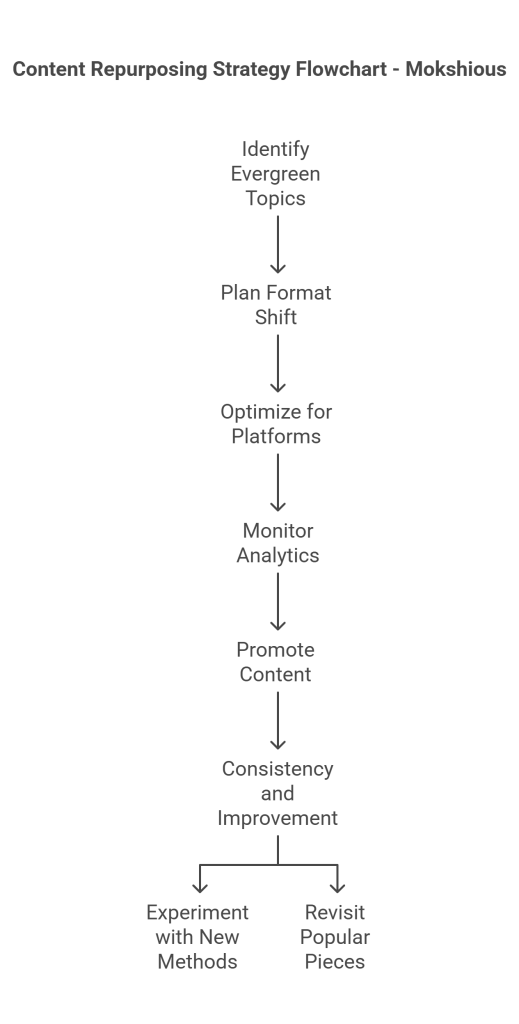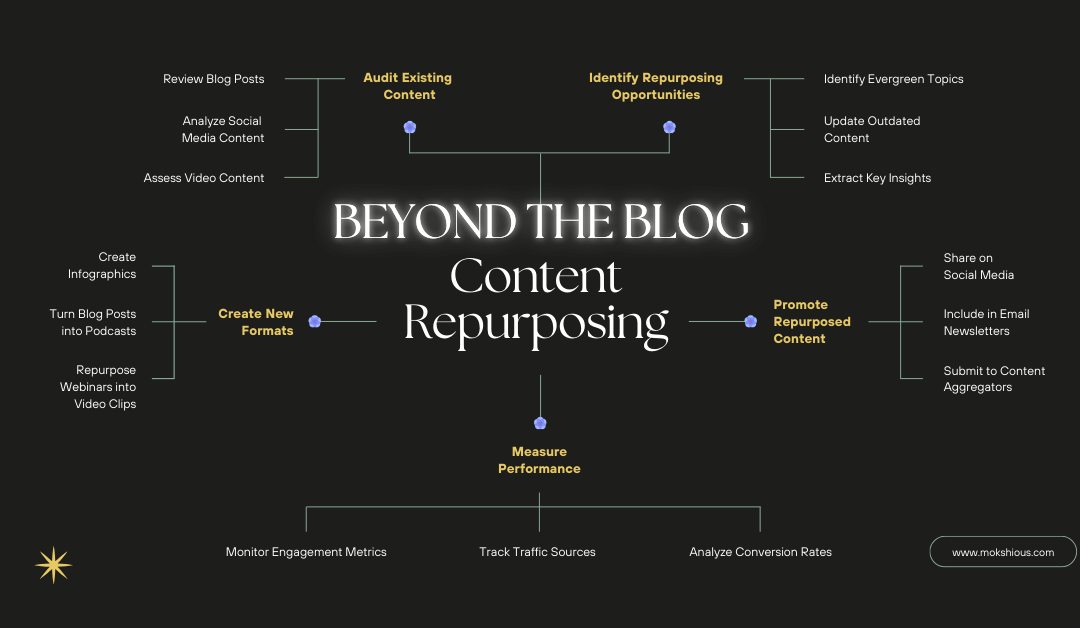Quick Overview
Content repurposing can be your most powerful ally in the relentless swirl of digital innovation. By strategically transforming a single piece of content into multiple formats, you can save resources, extend audience reach, and spark creative ways to repurpose content that propel revenue upward.
- What You’ll Learn: Why content repurposing is so crucial, the way to repurpose your blog materials across different channels, and how a structured repurposing strategy drives ROI.
- Who It’s For: Any business seeking to maximize the value of your content without having to create entirely new content.
- Why It Matters: This marketing strategy helps expand your brand footprint, incite engagement, and boost traffic, all while preserving precious time and budget.
The Benefits of Repurposing Content for Higher Engagement and Business Growth

Why Content Repurposing Matters
Content repurposing transcends mere recycling. In fact, the benefits of content repurposing include enhanced discoverability, stronger audience connections, and a more cohesive presence on social media channels. According to Mokshious and Content Marketing Institute, 2025:
- Fifty-three percent say it’s gotten harder to attract visitors from search engines.
- Seventy-four percent of bloggers create how-to articles. Other structures include lists (50%), guides and e-books (46%), news and trends (45%), opinion (43%), original research (43%), interviews (34%), webinars (26%), infographics (22%), and roundups (22%). The most effective formats, according to bloggers who produce strong results, are roundups, infographics, and original research.
The distribution approach also supports net new content initiatives by reducing the need to produce content from scratch daily.
- ROI-driven approach: By reusing content you already have, you broaden your digital footprint on social platforms, allowing your business to experience significant growth.
- Example: Repurpose content across a blog, a video content platform, and an email list to boost conversions, brand awareness, and inbound leads. This diversity fosters long-term synergy.
The ROI and Time-Saving Advantages
Repurposing existing content can slash hours from your production schedule. It also ensures every piece of content gets the attention it deserves rather than being overshadowed by the next new idea. The benefits of repurposing content become particularly evident when you realize that repurposing content saves your team’s energy for more advanced creative or analytical tasks.
- Repurposed content allows your content creator workforce to focus on refinement instead of endless brainstorming.
- Many studies indicate that an organized content marketing system that leans on repurposed assets can see a higher success rate in lead generation.
- By strategically updating old content with fresh data, you can keep your brand relevant without overhauling your entire library.
How to Repurpose Your Blog Post into Social Media Content Across Platforms

Identify High-Performing Blog Posts
Zero in on the blog posts that have historically drawn the most engagement or sign-ups. A thorough review of analytics tools, such as Google Analytics, Semrush, or Ahrefs, can spotlight the posts that resonate best with your target audience.
- Action Step: Compile a list of top performers, focusing especially on blog content that remains timely. Then, determine how each post might fit into a new format, be it text snippets, slides, or short videos.
Turn Blog Content into Engaging Social Media Posts
Repurposing content for social media fosters consistent brand messaging across a multitude of channels. For instance, you might turn an in-depth, long-form piece of content into a series of social media slides. This offers bite-sized, shareable insights.
- Action Step: Repurpose your blog content into five to ten social media posts. You could spotlight key data points, highlight impactful quotes, or even pose a question to spark dialogue.
- Example: On LinkedIn, craft a short post with actionable tips, linking back to the original blog for more details. On Instagram, develop quick-hit visuals that prompt immediate attention.
Format the Same Piece of Content for Different Platforms
Adapting content to fit each channel is non-negotiable if you want to engage distinct audiences effectively:
- LinkedIn: Emphasize data-driven insights and professional storytelling.
- Instagram/TikTok: Lean on visual content and crisp, captivating hooks.
- Twitter/X: Condense major takeaways into swift, punchy statements that spark retweets.
In each instance, repurposing content ensures you maintain brand consistency while honoring the platform’s norms. This balanced approach can lead to an increase in overall social engagement.
Strategies for Repurposing Existing Content to Maximize ROI

Repurposing Strategy Essentials
A well-organized repurposing strategy stands on the pillars of audience insight, deliberate planning, and consistent follow-through. By weaving in a guide to content repurposing within your editorial process, you gain clarity on how best to segment or recast your existing piece of content.
- Action Step: Sketch out your content distribution blueprint. Identify whether your audience is more receptive to podcasts, videos, or textual guides.
- Pro Tip: Update the content in your top-performing posts with fresh stats or user reviews to keep it ever relevant.
Turn Blog Posts into Multiple Content Formats
Sometimes, a single article can spawn multiple derivatives:
- Video content: Summarize your main points and add screen-shared demos or infographics.
- Infographics: Simplify complex data into visually appealing, quickly digestible formats.
- Podcasts: Hold a roundtable discussion or share expert opinions based on the post topic.
- X: Make a quick read thread of each article and, in the end, link back to the original article.
Repurposing content across these varying media outlets amplifies your visibility in ways pure text rarely can. Doing so also complements your broader content marketing strategy, funneling diverse audience segments into your ecosystem.
Repurpose Content for Lead Magnets and Email Campaigns
To create new content for lead generation, transform your existing content into checklists, eBooks, or PDF resources. For instance, you could compile a “Complete Guide to Repurposing Content” that website visitors can download.
- Action Step: Embed calls-to-action within email newsletters and invite subscribers to explore your repurposed resources.
- The outcome? Consistent traffic to your blog and heightened brand loyalty among your reader base.
Repurposing Strategy: Turning Blog Content into Video Content and More
The Value of Video Content
Video content resonates powerfully with audiences who prefer visual cues and in-the-moment explanations. According to recent Wyzowl research, 91% of marketers feel video is key to capturing user interest.
- Action Step: Turn your top-performing blog post into a three-minute snippet or an in-depth webinar. This agile approach to repurposing content can provide fresh vantage points and enhance brand credibility.
Social Media Content Expansions
Repurposing content for social media can be as simple as converting a textual piece into an animated short or as extensive as hosting live Q&A sessions.
- Each approach to repurposing your original post can align with the channel’s culture, whether it’s professional insights for LinkedIn or ephemeral visuals for TikTok.
Content Repurposing Strategy for Webinars and Podcasts
Convert a single blog series into a monthly webinar. Or pivot an article into a guest podcast episode to harness a broader listener base. Such strategies for repurposing content cultivate authority and encourage linkbait: partners and attendees often link back to your original article, fueling search rankings.
- Action Step: Feature thought leaders in your webinars or podcasts, creating a synergy that appeals to new sets of followers.
Measuring the Return on Your Content Repurposing Investment
Tracking Key Metrics
Determine the ROI of your content by repurposing efforts by monitoring traffic, conversions, and engagement rates on relevant channels. You could deploy UTM parameters for each platform to measure which channel garners the highest conversions.
- Gauging your return helps you refine future repurposing tactics. Are you leveraging the right type of content? Is your content on social media or your blog generating more leads?
Analyzing ROI-Driven Outcomes
Compare the performance of repurposed content projects with your legacy content marketing outputs. Does a reworked slideshow on SlideShare produce 50% more downloads than the original blog? Identifying these insights shines a light on the value of your content when shared thoughtfully.
- Action Step: Document the benefits of content repurposing, particularly the effect on lead funnels, brand awareness, and any synergy with social media content engagement.
- By sharing data on your successes, you motivate team members and stakeholders to invest more heavily in repurposing processes.
Best Practices and Creative Ways to Repurpose Your Content
Content Repurposing Tips for Higher Engagement
- Conduct thorough audits to update the content with new insights or external links.
- Incentivize user-generated content by prompting readers to share personal stories or experiences related to your blog topic.
- Combine smaller repurposed assets into a single content hub, giving your audience a convenient one-stop resource.
Quality content stands at the heart of every transformation, ensuring that each derivative piece still offers genuine value. Remember that repurposing content helps you meet audience needs in diverse ways.
Involving the Entire Team
Your editors, designers, and marketers can each bring unique perspectives that enhance the final product. Collaboration avoids fragmentation, leading to cohesive content strategy outcomes.
- Action Step: Maintain an editorial calendar for repurposing content across your social media channels. Align schedules so your team knows when and where the repurposed assets will be released.
The Way to Repurpose Your Content for Long-Term Value
To find a way to repurpose your content for continual relevance, systematically revisit your best-performing assets quarterly. Perhaps you can transform a single, evergreen article into a mini-course over time.
- Example: That old content about best practices in SaaS? With a little tweaking, it might become an advanced webinar or a short eBook. Such expansions are potent forms of repurposing your content for diverse audience pockets.
Final Checklist: Ensuring Maximum ROI from Your Repurposing Strategy

Repurposing Content Checklist
- Identify evergreen blog topics that performed well historically.
- Plan your next format shift, whether that’s a short video, infographic, or slideshow.
- Optimize for each platform by tailoring your tone, visuals, and calls to action.
- Monitor analytics to confirm that your repurposing strategy hits key metrics.
- Promote your newly repurposed content assets through cross-channel marketing, including email lists and influencer outreach.
Consistency and Continuous Improvement
In the realm of content creation, no approach is ever static. Keep testing new platforms or methods. Experiment with ephemeral stories, static reels, or immersive audio. Document results so you can refine your content marketing strategy and secure even better outcomes next quarter.
- Revisit popular pieces for new angles or updates. The possibilities for repurposing are vast, and each iteration fosters stronger brand recognition.
Conclusion & Next Steps

When done right, content repurposing can magnify the impact of every piece of content you produce. It’s a maximum utilization method that ensures your brand message travels well beyond its original container. By repurposing content across multiple streams, including social media platforms, webinars, and email campaigns, you can stretch your ideas into content in dozens of appealing forms. That, in turn, delivers a more consistent return on investment.
Ready to delve deeper? Share your triumphs or any creative ways to repurpose content you’ve discovered. Remember to share back here for reference; your peers will appreciate the insights!
This comprehensive roadmap on content repurposing can provide the robust framework you need to transform a single piece of content into a multi-platform force. Keep exploring, keep experimenting, and never hesitate to update the content for a modern edge.
